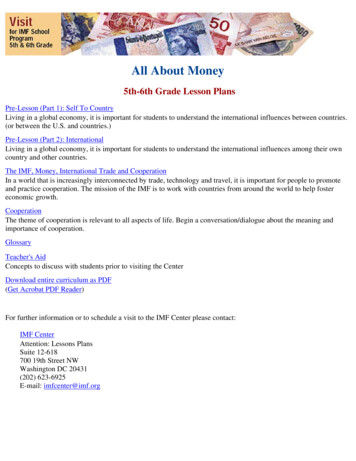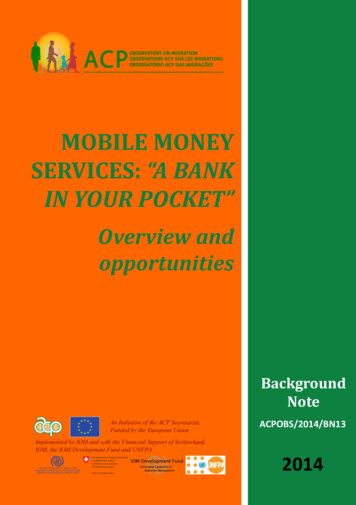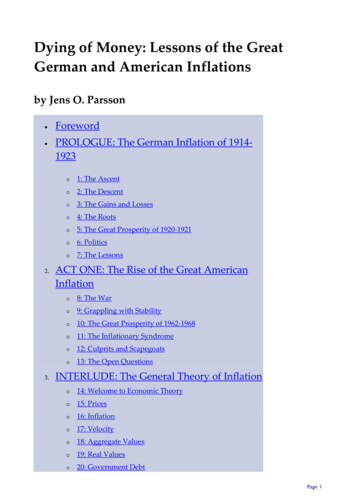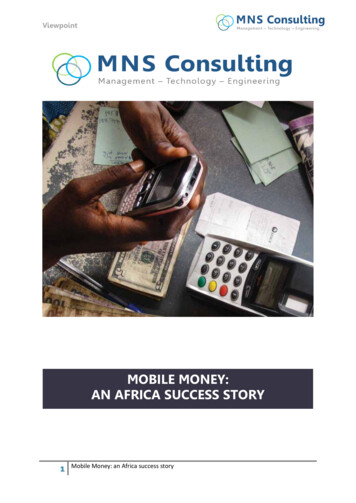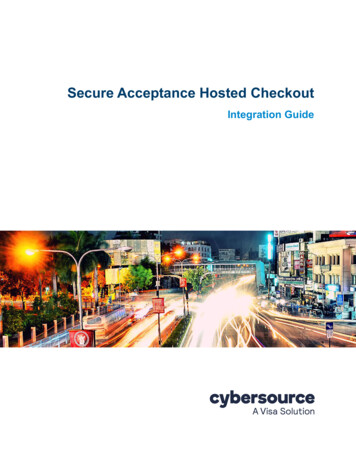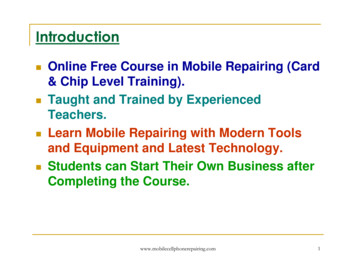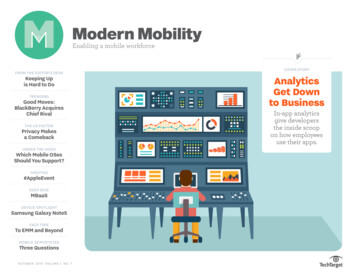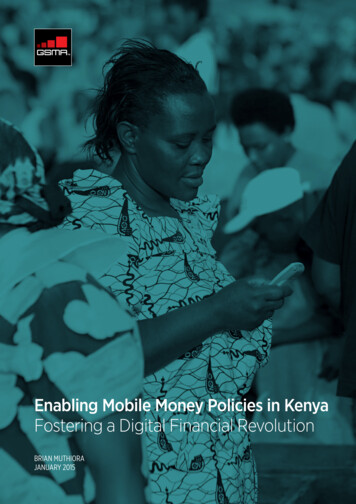
Transcription
GSMAEnabling Mobile Money Policies in KenyaFostering a Digital Financial RevolutionBRIAN MUTHIORAJANUARY 2015
ENABLING MOBILE MONEY POLICIES IN KENYAThe GSMA’s Mobile Money for the Unbanked (MMU) programmeworks to accelerate the growth of commercially viable mobilemoney services to achieve greater financial inclusion.For more information visit www.gsma.com/mmu
ENABLING MOBILE MONEY POLICIES IN KENYAForewordThe innovative use of mobile phone technology to drive financial inclusion in Kenya has been widely acclaimed around the world. Thiscase study is a useful addition to the body of literature on what has driven this success story. More importantly, it provides an update ofthe current state of Kenya’s mobile phone financial services terrain and teases out the possible future direction of mobile phone financialservices. In Kenya, we are now agreed that it can be described as a digital financial revolution.The Central Bank of Kenya (CBK) has been an integral part of this success, given Kenya’s aspirations laid out in the country’s blueprint fordevelopment, Vision 2030. Vision 2030 envisages a deeper and broader financial sector that contributes to improving the livelihoods ofthe majority of Kenyans, finances the growth of businesses, and funds the ambitious and transformative flagship projects underpinningthe Vision. Traditional models of financial services have not been transformative; only 18% of adult Kenyans were served by formalfinancial services before 2006.The introduction of mobile phone technology and its proliferation after 2000 provided a suitable platform for Kenya to leapfrog accessto financial services. The current success story of mobile phone financial services is testimony to this. CBK’s role has been to provide anenabling legal and regulatory environment. This has been based on a deep understanding of the business models, the risks they pose,and the appropriate risk mitigants.The outcomes of an enabling legal and regulatory framework, investment by dynamic private sector players, and adaptive and receptiveconsumers have been transformative. Access to formal financial services has increased from 26% of Kenya’s bankable population in 2006to 67% in 2013. Mobile phone financial services have played a key role in this. What began as money transfer services has now becomea platform with a menu of financial services that includes money transfers, payments of goods and services, savings, credit, insurance,pensions, and even capital market products.Much more remains to be done, as 25% of Kenya’s bankable population still cannot access any form of financial services. Moreover, thereis still room to enhance the usage and quality of financial services. Mobile phone technology holds the key to drawing more Kenyans intothe financial services net. More effort now needs to be focused on how to bring down the costs of financial services and improving theconsumer experience in accessing financial services. This will require continued and deeper public-private partnerships, the developmentof robust consumer protection and financial education frameworks, and the development of products based on a deep understanding ofconsumer behaviour, needs, and dynamics. The recently released Financial Diaries 2014 study in Kenya is a good starting point.As mobile phone financial services move to the next phase in Kenya, CBK will continue to play its part in providing an enabling legal andregulatory framework. The operationalization of the National Payment Systems (NPS) Act and gazettement of NPS Regulations in August2014 provides a firm basis for new innovations in mobile phone financial services and the deepening of national and regional paymentsystems. With its enhanced role, CBK will work with market players to enhance competition, reduce transaction costs, promote marketled interoperability, and scale up consumer protection. Indeed, Kenya is now uniquely positioned to move from a ‘cash-lite’ to ‘cashless’vision as mobile phone financial services transition to digital financial services.With both the Government and private sector working towards digital financial platforms, Kenya is certainly on a secure path to beinga cashless economy. CBK will continue to promote this transformation, which will deliver lower cost financial services conveniently andefficiently to the vast majority of Kenyans.Professor Njuguna Ndung’uGovernor, Central Bank of Kenya
GSMAENABLING MOBILE MONEY POLICIES IN KENYACONTENTSINTRODUCTION4THE EARLY STAGES OF MOBILE MONEY:CONCEPTUALISING A REGULATORY MODEL9THE DEVELOPMENT OF KENYA’S MOBILE MONEY MARKET15KENYA’S NEW REGULATORY FRAMEWORK19CURRENT MOBILE MONEY ISSUES IN KENYA24THE OUTLOOK FOR KENYA: A RAPIDLY SHIFTINGMOBILE MONEY LANDSCAPE26AcknowledgementsThe author would like to express his gratitude to Stephen Mwaura and Stephen M. Wambua from the National Payment SystemsDepartment at the Central Bank of Kenya for their invaluable contribution to this case study, and to Argwings Koyoson of AirtelAfrica, Isaac Kabere Njoroge and Mercy Buku of Safaricom, and Simone di Castri, Lara Gidvani, and Jeremiah Grossman of GSMA whocritically reviewed this document.1
GSMAENABLING MOBILE MONEY POLICIES IN KENYATHE KENYAN JOURNEYTO DIGITAL FINANCIAL INCLUSIONOUTREACH12.5MACTIVE MOBILEMONEYCUSTOMERS(30 DAY ACTIVE, MAR 2014)73.9MMOBILE MONEYTRANSACTIONSIN VOLUME(MAR 2014)192.6BNMOBILE MONEYTRANSACTIONSIN VALUEKSHS/MONTH (MAR 2014)FINACCESS 2013 SURVEYRESULTS RELEASED. 66.7%OF ADULTS HAVE ACCESS TOFINANCIAL SERVICES2.5 MILLION: THE NUMBER OFDEPOSIT ACCOUNTS IN KENYA5.4 MILLION: THE VOLUME OF MOBILEMONEY THROUGHPUT18.9% BANKED ADULT POPULATIONFINACCESS 2009 SURVEYRESULTS RELEASED. 39.9%ADULTS USE M-PESA TOTRANSFER MONEY6,104 MOBILE MONEYAGENTS ACROSS KENYA1.3 MILLION REGISTEREDMOBILE MONEY ACCOUNTSKES 1.17 TRILLION: THE VALUE OFMOBILE MONEY THROUGHPUT16.4 MILLION REGISTEREDMOBILE MONEY ACCOUNTS8.9 MILLION REGISTEREDMOBILE MONEY ACCOUNTS5.1 MILLION REGISTEREDMOBILE MONEY ACCOUNTS21.1 MILLION REGISTEREDMOBILE MONEY ACCOUNTS116,196 MOBILE MONEYAGENTS AS AT MARCH 2014MOBILE MONEY THROUGHPUTVALUE EQUALS 6.59% OF TOTALNPS THROUGHPUT VALUE19.2 MILLION REGISTEREDMOBILE MONEY ACCOUNTS26.2 MILLION REGISTEREDMOBILE MONEY ACCOUNTS(MARCH 2014)25.3 MILLION REGISTEREDMOBILE MONEY ACCOUNTSM-PESA PILOT FINISHESPOLICYSAFARICOM APPROACHESCBK WITH REQUEST FORAUTHORISATION OF M-PESAPILOT AS A MICROFINANCEREPAYMENT TOOLCENTRAL BANKOF KENYA GOESLIVE WITH RTGSNATIONAL TREASURY AND CBK RELEASEAUDIT FINDINGS AND GIVE M-PESA ACLEAN BILL OF HEALTHM-PESA CHANGES TOMONEY TRANSFER INSTEADOF MICROFINANCE.AUTHORISATION FOR MONEYTRANSFERSOUGHT FROM CBKDETAILED RESPONSE PROVIDED TO CBK.LEGAL OPINION DISTINGUISHES M-PESASERVICE FROM BANKING BUSINESSFINANCE ACT, 2009INTRODUCES CHANGESTO THE BANKING ACT TOALLOW AGENT BANKINGACTING MINISTER FOR FINANCE ORDERSAUDIT ON M-PESA AMID PRESSURE FROMKENYA BANKERS ASSOCIATIONCBK REQUESTS FORFURTHER INFORMATIONSAFARICOM PROVIDES DETAILED RISKMITIGATIONM-PESA PILOT STARTSIN THIKA, NORTH EASTOF NAIROBIVAT EXEMPTED ON ALLFINANCIAL SERVICES, INCLUDINGMOBILE MONEY TRANSFERCBK RELEASES AGENTBANKING GUIDELINESSAFARICOM AUTHORISED TO RECEIVEINWARD INTERNATIONAL REMITTANCESVIA WESTERN UNION, ALLOWING M-PESACUSTOMERS TO RECEIVE REMITTANCESDIRECT TO THEIR M-PESA ACCOUNTSCBK ISSUES ‘NO OBJECTION’ FORTHE LAUNCH OF M-PESACBK HOLDS FINALPUBLIC CONSULTATIONON THE DRAFT NPSREGULATIONSMARKET DEVELOPMENTCUSTOMERS CANACCESS M-PESASERVICES ATPOSTBANK BRANCHESM-PESA, KENYA’SFIRST MOBILE MONEYPLATFORM IS LAUNCHEDBY SAFARICOMCARDLESS ATM WITHDRAWALSINTRODUCED FOR M-PESACUSTOMERSLIPA KARO, A SCHOOL FEES PAYMENT SERVICEVIA M-PESA ANNOUNCED BY SAFARICOMSMEP, AN MFI, ALLOWS ITS CUSTOMERSTO MAKE REPAYMENT VIA M-PESAM-PESA FACILITATES BILLPAYMENTS AND BULKSALARY PAYMENTSSAFARICOMPARTNERS WITHKENYA POWERTO ALLOWCUSTOMERS TOPAY ELECTRICITYBILLS VIAM-PESAGRUNDFOS LIFELINKPARTNERS WITH M-PESATO ALLOW RURALHOUSEHOLDS TO PAY FORSAFE WATER VIA M-PESA.M-KESHO, AN EQUITYBANK ACCOUNT THAT ISACCESSED THROUGH THEM-PESA MENU IS LAUNCHED200620072008ORANGE (TELEKOM KENYA)LAUNCHES ‘IKO PESA’ INPARTNERSHIP WITH EQUITY BANK2009226.2M59%116,196REGISTERED MOBILEMONEY %22.1%ADULT POPULATIONUSING MOBILE MONEY(MAR 2014 AL24%76%60%80%MOBILE MONEY AGENT83%55%COMMERCIAL BANKS2%FORMALREGISTERED46%54%OFFSITE ATMs1%SACCOs1%23%201177%AIRTEL PARTNERS WITH VISA ANDCHASE BANK TO PROVIDE AIRTELMONEY CUSTOMERS IN KENYA WITHA NEW AIRTEL MONEY VISA CARDAIRTEL LAUNCHES “AKIBAMKONONI” A VIRTUAL SAVINGSACCOUNT HELD BY UBA BANKKENYA AND ACCESSED THROUGHTHE AIRTEL MONEY MENUM-SHWARI LAUNCHED AS A PARTNERSHIPOF COMMERCIAL BANK OF AFRICA (CBA) ANDSAFARICOM ALLOWING M-PESA CUSTOMERS TO EARNINTEREST ON SAVINGS AND BORROW MICROLOANS201266%OF RESPONDENTS SAID THEIRMOBILE MONEY ACCOUNTS AREVERY IMPORTANT IN THEIR FINANCESVERY IMPORTANT20132014SOURCE: CBK, 2013KENYA PAYMENT SYSTEMS STATISTICS2%10.5%VALUE IN NPS (KES BILLION)VOLUME IN NPS (‘000)MOBILE MONEY THROUGHPUT VALUE INTHE NATIONAL PAYMENTS SYSTEM (2013)6.59% FIs1%28%72%POSTBANK0%SOMEWHAT UNIMPORTANTBANK AGENT12%NOT AT ALL IMPORTANT83%SAFARICOM LAUNCHES‘LIPA NA M-PESA ONLINE’ALLOWING CUSTOMERSTO PAY FOR GOODS ANDSERVICES FROM ONLINEMERCHANTSSOURCE: FII KENYA 2013, BASE N 202327%17%40%% TOTAL ACCESS POINTS45%EXCLUDED2006MOBILE MONEYAGENTS(MAR 2014)YUCASH CUSTOMERS CANUSE POSTBANK BRANCHESTO REGISTER, DEPOSIT ANDWITHDRAW FUNDS FROMYUCASH ACCOUNTS3 MOBILE VIRTUAL NETWORKS(MVNOS) ARE LICENSED INCLUDINGFINSERVE AFRICA (EQUITY BANK),MOBILE PAY LIMITED (TANGAZAPESA) AND ZIONCELL MOBILE(MOBILE DECISIONING)AIRTEL LAUNCHES ‘BIMAMKONONI’ A LIFE INSURANCEPRODUCT UNDERWRITTENBY PAN AFRICA LIFEINSURANCE COMPANY ANDACCESSED VIA MOBILEAIRTEL MONEY AND FAULU KENYADEPOSIT TAKING MICROFINANCELAUNCH ‘KOPA CHAPAA’ ALLOWINGAIRTEL MONEY CUSTOMERS TOBORROW SHORT TERM LOANSHOW IMPORTANT IS MOBILE MONEY?FORMALNON-PRUDENTIALINFORMAL4.2%8.1%CO-OP BANK ALLOWSITS CUSTOMERSTO DEPOSIT ANDWITHDRAW MONEYFROM THEIR BANKACCOUNTS USINGAIRTEL MONEY(INCLUDES MOBILE MONEY)31.4200915.0%SAFARICOM PARTNERSWITH KOPO KOPO, THE FIRSTBUY GOODS AGGREGATORSOURCE: FSP MAPS, KENYAFINANCIAL ACCESS POINTS - BY TYPE AND LOCATION32.7%AIRTEL, HAVING ACQUIREDCELTEL KENYA, RELAUNCHES ZAPAS ‘AIRTEL MONEY’2010SOURCE: FINACCESS NATIONAL SURVEY 2013FINANCIAL ACCESS BY YEARMOBILE PAY LTD LAUNCHES ‘TANGAZA PESA’THE ONLY MOBILE MONEY SERVICE THAT CANSEND CASH ACROSS ALL NETWORKSSAFARICOM RELAUNCHES MERCHANTPAYMENT SERVICE AS ‘LIPA NA M-PESA’YUCASH AND COOPERATIVE (CO-OP) BANKPARTNER TO ENABLE YUCASH CUSTOMERS TOTRANSFER FUNDS TO CO-OP BANK VIA YUCASHYUCASH LAUNCHES CARDLESS ATMWITHDRAWAL SERVICE AT ALL EQUITY ATMSAIRTEL OFFERS ‘PAYONLINE’ THE WORLD’S FIRST VIRTUALPAYMENT CARD THAT ALLOWS AIRTEL MONEY SUBSCRIBERSIN KENYA TO BUY PRODUCTS ONLINE (PARTNERSHIP BETWEENAIRTEL, MASTERCARD AND STANDARD CHARTERED BANK)YUMOBILE (ESSAR TELECOM) LAUNCHES YUCASHCARE, EQUITY AND ORANGE LAUNCHA GROUP SAVINGS PRODUCTI&M BANK AND SAFARICOM LAUNCHA PRE-PAID VISA CREDIT CARD THATCAN BE LOADED VIA M-PESAKILIMO SALAMA INSURANCE PILOTLAUNCHED BY SYNGENTA FOUNDATION,UAP INSURANCE AND SAFARICOM. ALLOWSKENYAN FARMERS TO INSURE AGAINST CROPFAILURE, WITH PREMIUMS PAID VIA M-PESAZAIN KENYA (CELTEL KENYA LTD) LAUNCHES ‘ZAP’MOBILE MONEY AT A GLANCENPS REGULATIONSISSUED (AUGUST 2014)PROCEEDS OF CRIME & ANTI MONEYLAUNDERING ACT PASSED MAKINGMOBILE MONEY OPERATORS ‘REPORTINGINSTITUTIONS’ UNDER THE ACTCBK REQUESTS DETAILEDRESPONSE TO QUERIES ONM-PESA’S LEGAL STRUCTURE2005ANTI MONEY LAUNDERINGREGULATIONS ISSUED, BREATHING LIFETO THE FINANCIAL REPORTING CENTRENATIONAL PAYMENTSYSTEMS (NPS) ACT PASSEDBY PARLIAMENTNPS ACTCOMMENCEMENT DATEANNOUNCED10% EXCISE DUTY ON FEESCHARGED ON FINANCIALSERVICES INTRODUCEDSOMEWHAT IMPORTANT100%AUTHORS: SIMONE DI CASTRI, LARA GIDVANI AND BRIAN MUTHIORA - SEPTEMBER 2014.SOURCES: FINACCESS NATIONAL SURVEY 2006, 2009 AND 2013, FSD-KENYA; ENABLING MOBILE MONEY TRANSFER: THE CENTRAL BANK OF KENYA’S TREATMENT OF M-PESA, AFI CASE STUDY; MOBILE PAYMENTS DATA, CENTRAL BANK OF KENYA, APRIL 2013; M-PESA TIMELINE, SAFARICOM; MEASURING FINANCIAL INCLUSION: THE GLOBAL FINDEX DATABASE, WORLD BANK; BILL & MELINDA GATES FOUNDATION – FSP MAPS; INTERMEDIA FINANCIAL INCLUSION INSIGHTS; ADDITIONAL DATA AND INFORMATION FROM PRESS RELEASES, BLOGS, PROVIDERS’ WEBSITES, AND THE CENTRAL BANK OF KENYA.1,978KENYA ELECTRONICPAYMENT AND SETTLEMENTSYSTEM (KEPSS)2,73328,588AUTOMATED CLEARINGHOUSE1,902MOBILE PAYMENTS1,533PAYMENT CARDS3
GSMAENABLING MOBILE MONEY POLICIES IN KENYAIntroductionMany of the products conventionally offered by banks and even by microfinance institutions in Africa are ill-adapted to poorcustomers’ needs. By moving beyond what is generally established, modern technology offers some possibilities for leapfroggingsome of the obstacles placed by slow-adjusting infrastructures and other African environmental challenges.Stephen Mwaura NduatiHead of National Payments, Central Bank of Kenya1In the span of just seven years, Kenya’s financial services landscape has been dramatically altered. In 2006, only 26.4% of adults in thecountry had access to formal financial services, but by 2013, this had more than doubled to 66.7% (see Figure 1). Today, more peopleare sending and receiving money, opening bank accounts, and applying for loans than ever before.FIGURE 1ACCESS TO FINANCIAL SERVICES IN KENYA BY .1%15.0%27.2%FORMALNON-PRUDENTIAL31.4(INCLUDES MOBILE NFORMAL2006EXCLUDED4.3%0%20%40%60%80%THERE HAS BEEN AN INCREASE IN FORMAL PRUDENTIAL FINANCIAL INCLUSION OFINCREASE BETWEEN 2006 AND 2009.100%10.6% FROM 2009 TO 2013 COMPARED WITH A 7.1%THE DECREASE IN THE PROPORTION OF PEOPLE EXCLUDED BETWEEN 2006 AND 2013 WASBETWEEN 2006 AND 2009.6.0%, COMPARED WITH A 7.9% DECREASETHE PROPORTION OF PEOPLE RELYING SOLELY ON INFORMATION TYPES OF FINANCIAL SERVICES HAS BEEN STEADILY DECREASING.41.1 Stephen Mwaura Nduati (2011), “Enhancing Financial Inclusion through Technological Innovations”, The Fletcher School, Tufts University, Leadership Program for Financial Inclusion, Policy Memoranda 2011,available at http://fletcher.tufts.edu/CEME/ 20Final.pdf2.Financial Sector Deepening Trust Kenya, FinAccess 2013 Survey, Fig. 3.3, p. 13 available at 31 FinAccess 2013 Report.pdf
GSMAENABLING MOBILE MONEY POLICIES IN KENYAWhat has been driving this change? In Kenya, broad access to financial services has been made possible by mobile network operators (MNOs)leveraging their technology, ubiquitous distribution networks, and partnerships with banks to deliver mobile financial services to unbanked andunderserved segments of the population. Mobile money has enabled anyone in Kenya with access to a mobile phone to perform basic financialtransactions without having to use a bank account or rely on riskier, less efficient methods like delivering cash in person (see Figure 2).FIGURE 2PERCEPTIONS OF DIFFERENT REMITTANCE METHODS BEFORE ANDAFTER LAUNCH OF M-PESA364.3%47.8%31.7%26.2%25.8%50.4%M-PESA PERCEIVED AS FASTEST METHODAFTER LAUNCH BY RESPONDENTS.SPECIALIST MONEY TRANSFER SERVICE(34.9%) WAS PERCEIVED AS FASTESTBEFORE LAUNCHM-PESA PERCEIVED AS LEAST EXPENSIVEMETHOD BY RESPONDENTS, IN ADDITION TO‘FAMILY/FRIEND’ (44.2%). BEFORE LAUNCH,‘FAMILY/FRIEND’ WAS PERCEIVED AS LEASTEXPENSIVE (51.3%)‘SPECIALIST MONEY TRANSFER SERVICE’PERCEIVED AS MOST EXPENSIVE METHODBY RESPONDENTS AFTER M-PESA LAUNCH.BEFORE LAUNCH, IT WAS ALSO SEEN ASMOST EXPENSIVE (40.0%)3.RESPONDENTS PERCEIVED M-PESA ASEASIEST TO GET METHOD AFTER LAUNCH.BEFORE LAUNCH, ‘FAMILY/FRIEND’ WASPERCEIVED EASIER TO GET (51.6%)M-PESA PERCEIVED AS LEAST RISKYMETHOD BY RESPONDENTS. BEFORELAUNCH, ‘SPECIALIST MONEY TRANSFERSERVICE’ (19.4%) WAS PERCEIVED ASLEAST RISKYBEFORE M-PESA, ‘FAMILY/FRIEND’ WASPERCEIVED AS THE MOST RISKY METHODBY RESPONDENTS. AFTER M-PESA LAUNCH,‘FAMILY/FRIEND’ (42.7%) AND ‘BUS/MATATU’(45.8%) WERE PERCEIVED AS MOST RISKYFinancial Sector Deepening Trust Kenya, Financial inclusion in Kenya, survey results and analysis from FinAccess 2009 Survey, Table 7, p. 158 available 6-27 finaccess 09 results analysis.pdf5
GSMAENABLING MOBILE MONEY POLICIES IN KENYAMobile money users can make peer-to-peer (P2P) transfers, bill payments, and merchant payments, as well as receive socialdisbursements and international remittances. With 26.2 million mobile money accounts and 12.5 million active mobile money users,Kenya now has one of the highest mobile money penetration rates anywhere in the world.This remarkable growth in financial access can be traced back to 2007, when non-bank providers began offering mobile money productsand services,4 and the Central Bank of Kenya (CBK) adopted a progressive ‘test and learn’ approach to regulation. Rapid customer uptakefollowed, due in large part to a ubiquitous distribution network at the grassroots level, trusted brands, and relatively low-cost transactions(compared to existing money transfer methods).5 The Bill & Melinda Gates Foundation’s FSP Maps data, compiled in 2012 and 2013, showsthat there has been a dramatic increase in financial services access points driven largely by mobile money agent outlets (see Figure 3).59%OF ADULTS IN KENYA AREACTIVELY USING MOBILEMONEY PRODUCTSAND SERVICES ONA 30-DAY BASISThe role of the CBK in creating an enabling regulatory environment for mobile money cannot beoverstated. By providing incentives for service providers to invest6 and avoiding overly prescriptive orburdensome requirements, Kenya’s central bank has managed to encourage innovation and growthwhile preserving the stability and soundness of the financial sector. The result: 59% of adults in Kenyaare actively using mobile money products and services on a 30-day basis.7The impact of mobile money has been felt across Kenya’s financial services industry and in thebroader digital ecosystem as well. Mobile money has been an ‘on-ramp’ for Kenyans to use additionalfinancial services, such as deposit accounts, and has helped to improve the financial capability ofpreviously underserved segments of the population. The traditional financial services industry hasalso played an important role: more than 20 banks are now interconnected with mobile moneyservices, and at least one bank has obtained a mobile virtual network operator (MVNO) licence tooffer low-cost mobile banking services.8As Kenya’s mobile money market evolves, the CBK continues to anticipate and address challenges as they arise, and has recently formulateda regulatory framework to guide market conduct and consumer protection. The National Payment System (NPS) Regulations9 issued in 2014have codified many of the regulatory practices developed since the introduction of mobile money in 2007, when the regulator articulated aprudential framework that laid out requirements in ‘letters of no objection’ to mobile operators. The NPS Regulations also address emergingmarket conduct and ecosystem issues, such as competition, interoperability, consumer protection, and governance.64.The FinAccess Survey classifies mobile money in the ‘formal non-prudential category’ of institutions “which are subject to non-prudential oversight by regulatory agencies or government departments/ ministries withfocused legislation”. This segment has grown 121% since 2009 and 672% since 2006.5.Ignacio Mas and Amolo Ng’weno (2009), “Three keys to M-PESA’s success: Branding, channel management and pricing,” Bill & Melinda Gates Foundation, available .See also Simone di Castri (2013), “Mobile Money: Enabling Regulatory Solutions”, GSMA, available ons-di-Castri-2013.pdf7.Simone di Castri, Lara Gidvani and Brian Muthiora (2014), “The Kenyan Journey to Digital Financial Inclusion” (infographic), GSMA, available ent/uploads/2014/09/MMU 2014 Kenya-Pathway Infographic Web.pdf8.See infra, section VI.9.National Payment Systems Regulations, 2014, available at ion/NPSRegulations2014.pdf
GSMAENABLING MOBILE MONEY POLICIES IN KENYAFIGURE 3FINANCIAL ACCESS IN KENYA109259213210107412369973022 136916122979811622572KENYA13784 193729412 1131951341143FINANCIAL SERVICE LOCATIONSBANK AGENT (7,052)MOBILE MONEY AGENT11 (48,524)COMMERCIAL BANK (1,221)OFFSITE ATMS (503)MFIS (500)POSTBANK (93)SACCOS (706)MOBILE COVERAGE10. FSP Maps, Bill & Melinda Gates Foundation, 2013, available at http://www.fspmaps.com.11.According to FSD-Kenya, which coordinated the field research on behalf of the Bill & Melinda Gates Foundation, the FSP Maps data collated in 2012 (launched in 2013) comprised of physical access points without regardto the number of Agent Tills issued per outlet. Geographical locations experiencing security challenges, for instance the North Eastern Province, were not adequately covered. Similarly, agent locations within corporateestablishments, such as staff canteens, and national security installations, such as military barracks, were not mapped.7
GSMAENABLING MOBILE MONEY POLICIES IN KENYALessons from Kenya’s mobile money experienceWhat lessons can regulators, policymakers and operators draw from Kenya’s mobile money experience?Lessons for regulators and policymakers Regulators can be agents of change for financial inclusion. Kenya has low levels of financial exclusion in large part because of thefinancial inclusion policies implemented by the CBK, such as allowing non-bank financial service providers (FSPs) to enter the marketand deliver low-cost financial services to the unbanked and underserved. In permitting a non-bank to launch M-PESA, Kenya’s firstmobile-enabled money transfer and payment system, the CBK was making a bold statement: that it was committed to improvingthe efficiency of the payment system and the financial sector, standing on the side of innovation, and ensuring operational, legal, andliquidity risks were properly and sufficiently mitigated. The CBK is a bright example of a public sector authority enabling socio-economicdevelopment, and it has paved the way for other countries to initiate reforms to foster financial inclusion. Mobile money is a catalyst for financial inclusion and the development of the digital ecosystem. Mobile money providers are notfinancial intermediaries and do not undertake banking business. On the contrary, mobile money complements banking. Partnershipswith mobile money providers provide a cost-effective way for commercial banks and microfinance institutions (MFIs) to collectpublic deposits and offer credit services to new customers that are otherwise beyond their reach. Mobile money has also contributedto the development of the digital ecosystem by providing a readily available payment mechanism for many startups. Mobile money does not introduce systemic risk to the financial system. Data from the Central Bank of Kenya indicates that mobilemoney accounts for only 6.59% of total NPS throughput value despite very high transaction volumes,12 which means mobile moneydoes not, by itself, introduce systemic risk to the financial system. However, the high volumes transacted by large segments of thepopulation indicate that mobile money is a very important part of the financial system for consumers. To protect consumer interestand ensure services are sound, mobile money providers have implemented policies to prudently manage operational risk, safeguardand ring-fence customer money, protect consumers, and plan for business continuity.Lessons for operators Early and sustained engagement with the regulator is good for business. When seeking a licence to launch a new product, mobilemoney providers should engage with the regulator early on to understand the regulatory rationale, and provide all the informationthe regulator needs to understand their business and products. This demonstrates to the regulator a willingness to comply withthe prevailing regulatory environment. A coherent plan for engaging with the authorities and sustaining dialogue is essential toensuring the regulatory framework and business models remain compatible. Adapting to a dynamic regulatory environment is essential. Mobile operators must anticipate and adapt to changes in theregulatory environment, some of which can benefit the industry as a whole (such as non-exclusive dealings with agents), whileothers can be detrimental if not managed properly (such as burdensome tax policies). The development of the mobile money ecosystem creates many opportunities. As the mobile money ecosystem matures,providers can forge new partnerships to offer additional products (such as savings) or expand their business into other areas (suchas international money remittance). Mobile money interoperability is another opportunity for operators to tap into a larger marketcreated by combined economies of scale.12. Central Bank of Kenya, Payments Systems Statistics January–December 2013, -11-44-41/payment-systems-statistics8
GSMAENABLING MOBILE MONEY POLICIES IN KENYAThe early stagesof mobile money:Conceptualising aregulatory model“When regulators embrace a leadership role in developing the market, they become innovative and take reasonable risks inherent tomaking the changes needed to create a more inclusive financial sector. Although regulators’ main concern is always the safety andsoundness of financial systems, those that have made the most progress have been willing to explore new routes or to use new toolsto enhance traditional financial activities.”Prof. Njuguna Ndung’uGovernor, Central Bank of Kenya13M-PESA: A regulatory turning pointIn 2005, the Central Bank of Kenya was overseeing an underdeveloped financial sector that, despite high potential demand, sufferedunder the weight of inefficiencies and an inadequate statutory and legal framework to support the development of digital financialservices. More adults in the country were excluded from the financial system (38.4%) than had access to financial services (26.4%) (seeFigure 1, supra). Commercial banks were closing down rural branches due to the high operational costs of maintaining them. The CentralBank did not have much latitude in the legal or regulatory framework to deal with new products introduced by non-banks.It was against this backdrop that the CBK addressed an application by the Commercial Bank of Africa (CBA), Safaricom Limited, andVodafone Group to authorise M-PESA, a mobile-enabled money transfer and payment service. The CBK faced a stark choice: should itmaintain the status quo and refuse the application on the grounds that the legal framework does not permit the participation of nonbanks, or should it navigate the necessary risks to find a regulatory solution that would foster greater financial inclusion? It chose thelatter, giving rare audience to Safaricom and its partners.While the Central Bank of Kenya Act (CBK Act)14 gave the CBK discretion to “formulate and implement such policies as best promote theestablishment, regulation and supervision of efficient and effective payment, clearing and settlement systems”,15 the Act was weak onthe statutory authority required for the CBK to issue regulations on payment services generally. As will be discussed later, this statutoryauthority was granted when the National Payment System Act was enacted in 2012.13.Simone di Castri (2013), “A conversation with Professor Njuguna Ndung’u, Governor of the Central Bank of Kenya, on the critical policy issues around mobile money”, GSMA Blog, available ssues-around-mobile-money14. Section 4A (d)15. Ibid.9
GSMAENABLING MOBILE MONEY POLICIES IN KENYAThe first challenge Safaricom and the CBK had to overcome was ensuring product design was compatible with the existing legalframework (see Box 1). The CBK had to be satisfied that Safaricom would not be intermediating M-PESA customer funds, which theBanking Act restricted to licensed banks.16BOX 1BANKING BUSINESS AND RESTRICTIONS ON DEPOSIT-TAKINGThe Banking Act17 defines ‘banking business’ as:“the accepting from members of the public of money on deposit repayable on demand or at the expiry of a fixed period or after notice;the accepting from members of the public of money on current account and payment on and acceptance of cheques; andthe employing of money held on deposit or on current account, or any part of the money, by lending, investment or in any other mannerfor the account and at the risk of the person so employing the money.”18Section 16 of the Act has a general restriction on deposit-taking other than by “an institution which holds a valid licence or a dulyapproved agency conducting banking business on behalf of an institution”.A ‘deposit’ is defined as “a sum of money paid on terms:a. under which it will be repaid, with or without interest or a premium, and either on demand or at a time or in circumstancesagreed by or on behalf of the person making the payment and the person receiving it; andb. which are not referable to the provision of property or services or the giving of security.”19The CBK’s legal opinion was that, at the point at which cash was converted to mobile money, bank notes or coins would be exchanged at parvalue for an equivalent amount of mobile money. This electronic value would be reflected on the c
mkononi' a life insurance product underwritten by pan africa life insurance company and accessed via mobile finaccess 2013 survey results released. 66.7% of adults have access to financial services 21.1 million registered mobile money accounts kes 1.17 trillion: the value of 16.4 million registered mobile money throughput mobile money accounts
